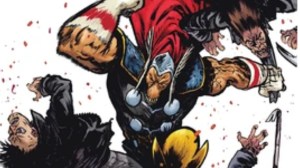
For three months in a row, The Immortal Hulk has topped Batman in direct market sales figures; that includes #16 in April, #17 in May, and #19 in June. Those issues represent a massive success that cannot be explained away. As we’ve addressed before Batman is a sales juggernaut that can hardly be compared to any other ongoing, superhero series. Yet Immortal Hulk has not only managed to compete with the reliable, best-seller, it has maintained its own growth in order to topple Batman month after month. It’s a big deal, and something worth investigating for readers, creators, editors, and retailers interested in spotting the next big thing because Immortal Hulk is, without a doubt, a “big thing” at this point.
Videos by ComicBook.com
Whenever it comes to comics sales, especially those counted in the direct market, it’s important to take nothing at face value. There are any number of strategies that publishers regularly utilize to increase units sold to retailers, even if it results in most of those issues sitting in back issue bins or being given away. However, there’s nothing to suggest that recent issues of Immortal Hulk have been a sales gimmick or fluke. The four most recent chapters of the series sold with various incentive covers, including an incredibly popular variant for Immortal Hulk #16 (from a total of 8 variants). While #17 also has a total of 8 variants available, #18 and #19 were sold with only 2 and 3 variant covers, respectively, and have maintained similarly impressive initial sales totals.
There’s little left to suggest that this unexpected increase in sales isn’t reflective of the series itself, which then raises one very big question: Why is The Immortal Hulk one of, if not the, most popular ongoing superhero comics today? That’s what we’re here to explain using our standard, investigative approach to exploring the strange world of comics sales.
Comparing Launches
There are a number of notable factors that can help us understand sales trends. We examined three in the course of investigation: Time, Creator, and Character. The first recognizes that every year in the direct market is a bit different from others, so comparing like-to-like means focusing on similar launch dates and style of comic. For Immortal Hulk that means superhero series, featuring characters and creators with some degree of recognizability, that were launched with a new #1 issue around June of 2018. Luckily, there were six notable launches all from the same month that match this criteria perfectly, all listed in the graph below.
While these series were all launched at the same time, they have run on different schedules, with some published more often than monthly, meaning this graph reflects the overall life of each series so far (not a crosstime comparison between issues):

This graph doesn’t provide the most useful visual for comparison, though, even after the #1 issues have been removed (thus excluding the many incentives for buying more issues than will be sold by retailers). Justice League is clearly the most popular series, while the others vary in initial expected readership sales between 65,000 and 30,000, a notable variance.
What is more valuable is observing how these expected readerships change over time, which led to our construction of a new charting method for readership trends. The second chart below provides the same data reorganized by the percent change in sales starting with the second issue and removing any singular, major variances (roughly 50% change) caused by incentive covers or other factors not based upon expected sales. The result makes it much easier to compare series in this and other sets of data.

Focusing primarily on how a series increases or decreases its readership over time provides a new, visual narrative, one that shows series like Justice League and Doctor Strange to be similar in trends, despite possessing differently-sized audiences. While crossovers with “War of the Realms” and other factors still provide temporary bumps, the general trend amongst 5 of these 6 series is clear. Sales slowly decrease over time, losing at least 25% of the initial readership, but never more than 50%
Immortal Hulk shatters that trend in two ways: First, the steady decline evident in other series does not exist in a meaningful fashion for Immortal Hulk. Prior to #16 it hovers around 0% net change in sales. Initially, there is a small increase, followed by a small decrease, but it never declines more than 7%, whereas every other series sees declines of at least 30%. Second, there is the growth beginning with Immortal Hulk #16, increasing total sales by approximately 100% and then retaining most of those sales for 3 subsequent issues. It is rare for any ongoing superhero series to grow and retain its readership by any degree, much less that shown in both of the above graphs.
One thing is clear looking at the past year of sales within these very similar series: The Immortal Hulk is unlike anything else in the direct market today.
Comparing Creations
There are other factors at play beyond the genre and timing of the series, though. It’s also worth noting how readers respond to specific creators. Immortal Hulk has regularly utilized the same core writer-artist team of Al Ewing and Joe Bennett. For the sake of this study, we will only be comparing it to Ewing’s other, recent superhero series. This is due to Marvel Comics’ (and the direct market’s) tendency to market ongoing series primarily on the attached writers, emphasizing a writer’s brand over multiple series and regularly changing artists during a series’ run. This is not a commentary on Bennett’s contributions (which are tremendous), so much as the inconsistent track record and emphasis placed on artists by the current status quo.
With that in mind, we compared Immortal Hulk to the 4 most recent Marvel Comics ongoing series written by Ewing (merging both halves of Ultimates into a single, ongoing series).

The stark difference between Immortal Hulk and Ewing’s other recent Marvel co-creations reflects what was seen with the time-based grouping, as well. All four of the prior series follow the established pattern of steady declines with no notable increases in readership (excluding the relaunch of Ultimates as Ultimates 2 for a new #1 that was excised from this chart). There’s not even a clear increase in Ewing’s readership here. The two series that lose more than 50% of units sold by #8 are more recent than the pair which retain more than 50% of units beyond #12. While Ewing has remained a critical darling in superhero circles since the debuts of Loki: Agent of Asgard and Ultimates, his name appears to not be a magic ingredient in boosting readership.
Comparing Characters
There are few factors more important in superhero comics than the existing intellectual property, though, making it important to consider how the name “Hulk” affects a series ongoing sales. As we’ve noted before with Batman, timing and creators might have a marginal impact on the series sales, but Batman always sells well with consistently diminishing returns as the series moves further from its launch point. Hulk is a character that has been packaged with a variety of titles and creative teams, but also one that has almost always been represented by some form of ongoing series across the past decade. We compared Immortal Hulk to the 4 most recent volumes representing the “main Hulk series” in some form or another.

The overall trends for assessing Immortal Hulk are retained: other Hulk series face diminishing returns with no substantial growth through the first 20 issues. However, there’s also considerably greater consistency within this cohort, again suggesting that specific characters have an impact on sales. While all of these series launched with a reasonable range of anticipated readership (approximately 40,000-60,000), they also retained that readership at a steady pace. Hulk doesn’t face the larger loss of readers by less recognizable brands like the Inhumans or Ultimates. However, past performance doesn’t suggest that a Hulk comic should fare any better than Justice League, Thor, or (most significantly) Batman.
So how does one explain The Immortal Hulk?
The Unstoppable Hulk
Time, creators, and character all have some place to play in this story. Releases from June 2018 provide a baseline expectation for success, one where any series even approaching 6-digit sales after an entire year is impressive. Ewing and Bennett have both been recognized as consistently talented creators, with Ewing specifically bringing a cult following of readers and critics to each comic. Hulk is a known quantity that provides reliable initial sales and a slow decrease in readership. Even when taken together, all three of these factors don’t add up to explain what is happening with Immortal Hulk. They suggest the series should be doing well, but that would ordinarily mean selling between 35,000 and 50,000 copies. The series has been selling close to 100,000 copies for four issue across three months.
That leaves the bump witnessed with Immortal Hulk #16 and its subsequent success open to interpretation. The data doesn’t offer any easy answers. There is one last thread to this narrative that might provide a strong reason for the consistency and growth: Word of mouth.
The very first issue of Immortal Hulk was released to widespread praise, the sort of hyperbole that many comics fans are used to, but perhaps with even greater consistency. That level of hype did not decline with subsequent issues. Critics and fans have remained excited about each new installment of the series, discussing new twists and expansion with seemingly ever last-page reveal. The closest comparison for consistent quality and change in modern comics may be Saga.
That consistency helps explain the series’ initially reliable sales, sales that all fell all within about 10 points of Immortal Hulk #2 for 14 issues. It could also explain why the high sales for Immortal Hulk #16, sales impacted by popular variant covers, expanded and retained that readership. While it might seem an unsatisfactory explanation, Immortal Hulk is selling so well because it is every bit the critical darling it has been made out to be. Something in this mix of creators and characters is hitting at the exact right moment. The sales show that it’s a bona fide success and one that publishers cannot easily replicate, no matter how much they may want to.








![Simu Liu Confirms The 2 Dream X-Men Shang-Chi Works With On Avengers: Doomsday [Exclusive]](https://comicbook.com/wp-content/uploads/sites/4/2025/12/Simu-Liu-Avengers-Doomsday-interview.jpg?w=300)